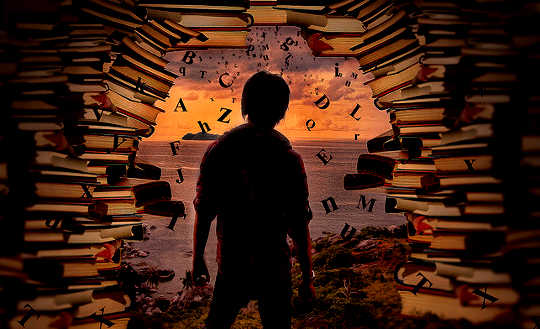
Though challenges like dyslexia can make learning difficult, these disabilities shouldn’t define who you are – or what you can do. Tim Kwee, CC BY-NC
I am an educator of educators. I teach others how to be the best teachers. But, I’m also different.
I have learning challenges.
As we celebrate the anniversary of the Americans with Disabilities Act (ADA), I’m reminded of my personal journey.
My disabilities could have defined me. But they did not. I don’t consider myself dyslexic or learning-disabled.
I am Jim. And here’s the story of how I overcame my challenges and found my life’s calling – and of the dedicated educators who helped me along the way.
My disability
Born in 1970, I suffered a head injury as a young boy while roughhousing with friends. Maybe that led to my learning problems. Maybe it didn’t. Doctors aren’t really sure.
What I do know for sure is that in kindergarten, I couldn’t spell my name: James. That’s when I became Jim. Over a period of time, I turned Jim into Mij.
I didn’t like school. I decided it was about one thing: learning to read and write. I was poor at both.
I didn’t like myself.
At the age of six, I was diagnosed with dyslexia or a minimal brain dysfunction with learning disabilities. At the time, awareness about dyslexia was so poor that my mother asked, “Is it contagious?”
Then something changed.
In 1975, Congress passed Public Law 94-142, now known as the Individuals with Disabilities Education Act (IDEA). This law provided special education services for all students with disabilities.
A breed of new educators – called special education teachers – came to my school in East Texas. They developed a curriculum tailored just for kids like me. The curriculum provided reading and writing experiences using specialized learning strategies. My teachers helped me learn to read books by looking at pictures, acting out stories and reading text.
Left, right, tar
A crucial event occurred in my second year of first grade that helped crystallize the visual cues I was being trained to see.
It was the summer of 1977. The roads of my small town were being resurfaced with asphalt and tar and I did what any inquisitive young boy would do: I stepped right into the middle of the warm, gooey stuff.
Predictably, it stuck to the side of one of my shoes.
The next morning, I lined up the shoes so they stuck together perfectly. Next, I slid my feet into the correct left and right shoes.
For the first time, I was able to place my shoes on the right feet using that sticky tar as visual and kinesthetic cues that my teachers had taught me. I was independent.
This was the beginning of understanding visual cues to learn to read, write and tell left from right. Even though it still took a while, I learned to make the connections.
For instance, when one of my teachers told me I needed to write on the correct side, I still didn’t understand. I asked, “What’s the correct side?” She said, “Write from left to right.”
I asked what are left and right. She took my paper, moved the holes of the paper to one side of my desk and said, “The holes face this way, left.”
I looked in that direction and saw these huge windows.
I still remember thinking, “This is like my shoes and that tar.” I knew it was unlikely the windows would move, so every time I began to write, I moved the holes of my paper toward the windows.
I learned to adjust to my visual landmarks if my desk moved by asking people what was my left.
I never wrote on the wrong side again.
Legs, loops, letters
Once I understood spatial relationships, I made new discoveries with letters and numbers, finding that some have “legs” and “loops” that faced the holes in the notebook paper while others faced in the opposite direction.
For instance, letters and numbers like a, d, 7, 3, and Jj faced the holes, while Bb, L, Ee, Ff, and Cc faced away from the holes. There were confusing ones like Zz, 5, Ss, and 2 that had loops and legs that faced toward and faced away from the holes on the notebook paper. I had to memorize or review them each time.
As I learned to write, I learned to read better too. I could call some words out orally and use pictures to fill in the missing parts.
Using visual cues and working with my peers and teachers were the solutions to learning, reading and writing. Also, I could persuade peers to read to me, and piece the meaning together like a puzzle.
Later, using visual cues helped me play football and drive a car. And it all started with tar and some teachers holding my hand.
College and beyond
Learning with learning challenges is never easy. But higher education proved to be an even greater challenge.
Spelling often seemed to me to be an insurmountable challenge. Professors required me to type my papers, but the end result resembled patchwork drywall thanks to the amount of white correction tape I used to correct misspelled words.
That’s when I found something that was as life-changing as the tar-on-my-shoes experience: the invention and availability of the personal computer.
I purchased an IBM clone with a word processing program that would review and check spelling. Once I used the word processor to complete various written assignments for college, I was like a caveman who discovered fire. I could turn in clean documents without worrying about handwriting legibility or the letters facing the wrong direction.
I was free. I could be a writer.
I completed my bachelor of science degree in psychology with a 4.0 grade point average. Later, while working as a schoolteacher, I completed my master’s degree in special education and my doctor of education degree in curriculum and instruction, again with a 4.0 grade point average.
Making a difference
I’m now a teacher. And as an associate professor at Tarleton State University, I work with students and their parents to focus on their abilities and not their disabilities – just like my teachers did.
And I still face the same learning challenges that I did as a young boy.
My experiences and challenges have enabled me to listen to my students more. I model every day the value of building relationships and collaborative learning. My school days taught me that learning occurs best when done together.
In 2016, the students at my university selected me as a speaker for Tarleton’s “Last Lecture” speaker series. I shared my story. I wanted our students with disabilities to know, “You are not alone!”
Since this speech, I’ve had numerous students and professors come up to me to describe various learning challenges they’ve endured for most of their lives. Many of them are still working to overcome these challenges today.
This experience has helped me to discover that we’re all working to do our best with the challenges we face. Hiding or ignoring learning challenges is lonely and sad. We all – humans, I mean – have challenges in common. If anything, sharing and overcoming them together is the new reality.
We’re all different, and that’s a good thing. Remember that you have something to offer the world: a thought, a story, a new way to do something or some creation that may change the world for the better. Please be brave and overcome that challenge. We need you. You belong. You’re not alone.
The Americans with Disabilities Act and the Individuals with Disabilities Education Act before it have given me and others like me the opportunity to thrive.
And what a difference that has made in our worlds.
{youtube}cyC-7e4MbJE{/youtube}
About The Author
James Gentry, Associate Professor, Tarleton State University
This article was originally published on The Conversation. Read the original article.
Related Books:
at InnerSelf Market and Amazon























